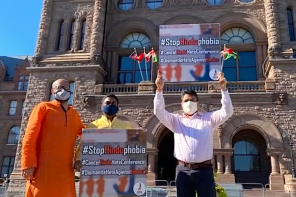During the months of May and June pilgrim-tourists in the millions make their way up into the mountains of the north Indian state of Uttarakhand. Their destinations include the divine sources of the Yamuna and Ganga rivers, the abode of the god Shiva in Kedarnath, the famous residence of the god Vishnu in Badrinath, and the Sikh site of Hemkund Sahib, associated with Tenth Guru of the Sikh tradition, Guru Gobind Singh.
This year in mid-June the monsoon rains came early and poured down upon the Land of the Gods with the sort of unexpected intensity that comes once in centuries. Flash flooding, landslides, and rising waters stranded tens of thousands of visitors and destroyed roads, buildings, livelihoods, and bridges. It is too early to know how many people have died but the number will probably be in the thousands.
The numbers may be low compared to global-scale disasters of recent years, but there is a wrenching poignancy to what is happening in Uttarakhand right now. Many of the forces that frame daily life in South Asia are suddenly on display like a raw wound: the wages of development and globalization, the power of the natural world, divine agency, altruism, self-interest, and the political nature of both government action and religious ritual.
The immediate impact of this flooding on Uttarakhand is extreme. The lasting impact on family life, labor patterns, regional economy, and levels of education, as Ravi Chopra and Malavika Vvawahare have passionately observed, will be an even deeper wound.
Flooding has hit the entire state hard, but one memorable face of this disaster will be what happened to the pilgrimage site of Kedarnath, a place about which I have been researching and writing for much of the past decade. It appears that a cloudburst fell with such intensity that it caused a lake located above and behind Kedarnath village to suddenly break its boundaries. Water and rock rushed down onto the site, killing hundreds and marooning thousands.
About seven kilometers south this surge utterly destroyed the village of Rambara. As I write this I still do not know in perfect detail which of my friends and acquaintances survived. I do know, however, that a very good friend did not. I have since managed to speak with several other friends who were in Kedarnath and managed to escape. In speaking of what those moments were like, one said “I saw Shiva’s tandav” (the god’s dance of destruction).
I said I could not imagine.
“Good,” he replied.
Early Indian media coverage, as well as state and central government relief efforts, focused on the famous site of Kedarnath and the plight of those visitors to Uttarakhand who needed to be physically rescued. In 2013, even Himalayan pilgrimage tours can reasonably be expected to be somewhat safe, beyond the occasional threat of landslide—it is not like in earlier days when setting out on pilgrimage meant the possibility of never returning.
The grief and shock of surviving a natural disaster is thus for many intertwined with a sense of bewilderment and ambush that renders such accounts all the more compelling. Yet the arresting images of post-flood Kedarnath and intense pathos of interviews with survivors who were visitors to the region displaces attention from local concerns.
The relative lack of attention to those who call Uttarakhand home is perhaps even more distressing because it reenacts the ways in which the health of local communities has in recent decades taken a backseat to the development of infrastructure for visitors, the building of hydroelectric dams, and logging projects. Particularly since Uttarakhand became a separate state (first as Uttaranchal) in 2000, the region has seen a massive rise in the number of visitors to the region, especially by the growing Indian middle class. Roads widened and hotels and visitor services grew exponentially. Building a new hotel or a restaurant by the side of the road felt like a smart investment—even when the road was near a river.
Kedarnath saw the building of new cell phone towers, a railway reservation office, helicopter landing pads, lodges with hot water available in the room. Prices soared. When a wave of water and rock crashed down upon Kedarnath last month it crashed down upon a site bursting at the seams—had this event happened twenty years ago deaths and destruction would have been far, far less. This disaster feels to me like the bursting of a bubble.
For many the floods wear the face of divine agency. Shiva has demonstrated his destructive power, it is said, because he is angry with the de-sacralization of pilgrimage and the lack of care with which the Himalayan environment has been treated. But the mixed flow of mountain rock and water is about more than Shiva’s power to destroy. This can be seen in what is emerging as one of the visual memes of this tragedy: an AP photo of the submersion of a statue of Shiva dozens of feet tall that has been a landmark in recent years of the city of Rishikesh.
This now-iconic image—the god’s head and shoulders battered by flood waters—is not just an indication of how high the river rose, it is also an index of Shiva’s nature. Shiva’s matted hair cushions our world from the full power of the goddess Ganga as she descends for our human benefit in the form of the Ganges river.
Shiva cannot be separated from shakti, the cosmic energy found in forms of goddesses such as Ganga. One of the most common ways to worship Shiva is to pour water onto his physical form: the aniconic shaft of the linga, held in its ovoid yoni base. This ritual act of pouring water reenacts the union of male-female, the indivisible nature of energy and matter.
From my mostly helpless location in Stevens Point, Wisconsin I have been following events through telephone, Internet media, and Facebook postings. On June 24, 2013, the Hanuman Fan Club on Facebook, a group devoted to the deity Hanuman, posted an old pre-flood image of the Kedarnath temple. Hindi text introduces the image, noting that of all the structures in Kedarnath only the temple survived because “It was connected to the faith of millions and therefore Mahadev [Shiva] did not allow it to tremble.”
It should be noted that cell phone towers also appear to have survived. The range of sentiment expressed in the comments this posting generated, of which at last count there were 2133 (along with 2917 “likes”), is striking. Some express the opinion that this destruction is the direct result of frank commercialism. Others take issue with Shiva’s seeming whimsy at choosing who lived and who died, or ask why the survival of the temple matters when family members are dead. But the majority of the comments are expressions of praise and reverence: “Long live the lord of Kedarnath” (“Jai Kedarnath baba ki”), “Long live Bolenath [sic] ( “Long live the lord [Shiva] who is innocent and simple”), or simply “O god of gods, destroyer, destroyer” (“har har mahadev”), an acknowledgement of human limits in the face of such power and tragedy.
Connecting these events to Shiva is also a way of thinking about human agency and human responsibility. As Chitra Padmanabhan notes in her editorial in The Hindu, the story of how the goddess Ganga descends honors the humility of her human supplicant, the king Bhagiratha, a humility that Padmanabhan argues should be mapped onto how humans relate to their physical environments.
Many voices in the last two weeks have said that this is exactly what has not been happening in Uttarakhand. Both the flash flooding itself and the resultant destruction—both of human life and of property—may have partially derived from a terrible combination of preexisting conditions: unplanned construction without regulation, deforestation, hydroelectric dam construction, and an unwillingness to slow down the pace of development in the face of ever-rising numbers of visitors to the region.
Ravi Chopra has noted that for the careful observer of Indian weather patterns of the last two decades the intensity of the flooding should not have come as the utter surprise that it did.
These broader trajectories underlie what is happening now. From the safety of my office, as I read the news and engage with observers online, I am observing two opposite trends developing: gratitude and praise for countless examples of human heroism and generosity, and outrage at reports of acts of unimaginable selfishness and the intrusion of politics into relief efforts.
On the one hand, evacuees cross a river on a bridge whose floor consists entirely of Indian soldiers. Residents of affected areas provide shelter and food for those who have survived. On the other hand, there are stories of shocking venality, ranging from post-flood looting in Kedarnath to tales of price-gouging. People are criticizing the government the way Americans did after Hurricane Katrina. While the state government insists it is doing everything possible, for many this is a tragedy of largely human origin—and to even attempt to connect these events to divine agency is an affront.
In the days, and now weeks, after the flooding, Kedarnath continues to draw national attention. A simple Google search for “Kedarnath” now turns up hundreds of articles, images, and videos produced in the last two weeks. The resources of an entire nation notwithstanding, the difficult location has meant that evacuations are only possible by helicopter and then only when the weather permitted, forcing events to unfold very slowly. Hundreds if not thousands of dead are trapped in the mud and rubble both in Kedarnath and south towards Rambara and beyond.
The Uttarakhand government is in the midst of addressing several connected problems, each of which has begun to generate controversy: the disposal of the bodies to prevent the spread of disease, the identification of the bodies so that families can be notified, and the mass cremation of the bodies in a way that is religiously appropriate. Some Uttarakhand residents protested this decision, saying that the state government was proceeding with mass cremation in order to prevent the true number of deaths in and around Kedarnath from ever being known. One of the government organizations involved in rescuing survivors reportedly refused to assist with cremations.
Even as the state government continues to conduct disaster relief there has been a wincing degree of political theater. A debate is developing about how the Badri-Kedar Temple Committee, the state governmental organization in charge of Kedarnath, has chosen to preserve the continuity of ritual worship of Shiva in his Kedarnath form.
Chief Minister of Uttarakhand Vijay Bahuguna, who is affiliated with the Congress party and whose office makes him the lightning rod for criticism about both disaster prevention and disaster relief, has rebuffed the efforts of Narendra Modi, Chief Minister of Gujarat, to be officially involved with the rebuilding of Kedarnath. Modi is one of the most famous faces of the Bharatiya Janata Party, the main national rival of the Congress party. At the same time, Uttarakhand has announced that the rebuilding of Kedarnath will take place in partnership with the Archaeological Survey of India, a national organization connected to the central government.
The temple is going to be rebuilt, better than ever, with safeguards in place against future flooding. The families of those who died in the Uttarakhand floods will probably receive some compensation from either state or federal governments. The state government is planning special economic compensation for those residents of the Kedarnath valley whose livelihoods were destroyed. It is very unlikely that this compensation will be sufficient unless it is long-term and continuous.
At least in the short term, it is clear that questions of responsible development are now going to be front and center in Uttarakhandi public conversations. But the impact of this flooding cannot be erased—in a seasonal tourist economy, it is difficult to catch up once you are several years behind.
Malavika Vyawahare has painfully and eloquently charted the impact the flooding will have on the village of Joshiyara, located in Uttarkashi district of Uttarakhand. One of the people she interviewed, Amod Singh Panwar, said “I don’t see the point of starting over.”
As time goes on the impact of these terrible days will be harder and harder to see unless we insist upon following up on local stories. This means moving beyond legible points of engagement like famous temples and the anger of a well-known deity.
Kedarnath is a religious symbol of such cultural, political, economic, and historic significance that, one way or another, it will surely re-open with a better long-term plan for the development of the site. But I am worried about the kind of rebuilding that is only occasionally newsworthy. I am worried about what will happen to the families like those of the men and few women who were caught by the waters in the small village of Rambara where I used to stop for lunch on the walk up to Kedarnath.
It is now buried in mud.
I am worried about my friend Vikram who has a B.A. in economics and who bought ponies to carry people to Kedarnath instead of trying to find salaried work because it was far more lucrative—and whom I have not yet been able to reach.
I am grateful to Data Ram Purohit, Pankaj Semwal, Sridhar Prasad Semwal, Brian Pennington, James Lochtefeld, Ajftab Jassal, Paul Courtright, Joyce Flueckiger, Laurie Patton, and Lois Whitmore for their assistance in writing this piece.




